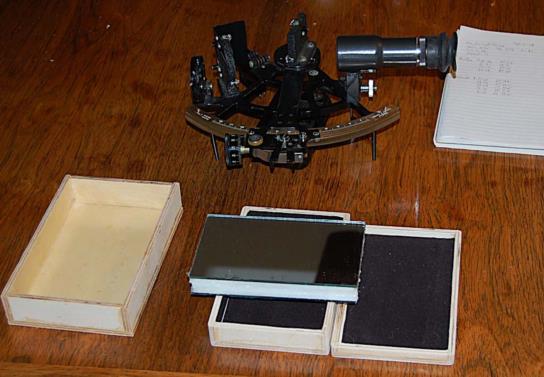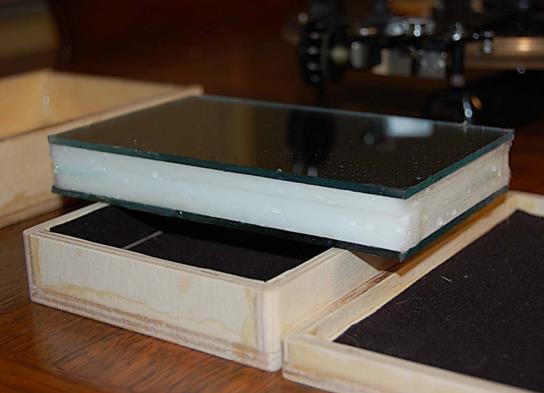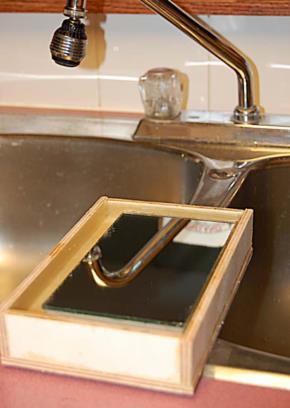
NavList:
A Community Devoted to the Preservation and Practice of Celestial Navigation and Other Methods of Traditional Wayfinding
Hybrid Artificial Horizon
From: Ken Muldrew
Date: 2008 Sep 11, 14:07 -0600
From: Ken Muldrew
Date: 2008 Sep 11, 14:07 -0600
For those of us who navigate from our back yard, for fun, practice, or
just as an excuse to watch the night sky, an artificial horizon is a
necessary part of our kit. Now that mercury is hard to come by, and a bit
of a nuisance anyway, most of us use a tray of water to reflect the object
that we are trying to get an altitude for. This works well for the sun and
moon, and is OK for bright planets, but it can be a trying experience to
bring down stars. As an alternative, some people of a metrological bent
will level a mirror or piece of glass, but this is a real challenge in
precision, and the trying leveling process has to be repeated every time
the mirror is moved (some back yards have a lot of trees). I think that
everyone who tries this in the dark begins to wish they had a jar of
mercury that they could just pour out and start observing.
I decided to try to combine the two approaches by floating a mirror on
water. I had no wish to try to build a perfectly balanced, hollow mirror,
so I thought that I could just mark the surface so that I would always use
it in the same orientation and the error could be calibrated, just as is
done for the index error with a sextant. So I bought a mirror, cut it in
half, and used silicone sealant to glue strips of 1/4" plexiglass around
the sides. The mirror was 1/8" plate glass (it was actually a front
surface mirror, but polished on the back, so I used it as a rear surface
mirror to protect the coating). I used 3 pieces of plexi on each side to
end up with a sealed box that was about 6" x 3.5" x 1". I built a tray to
float it that was just a bit bigger so that I could stick my fingers in on
the sides and remove the mirror from the water. The attached pictures show
the whole setup.
Last night Jupiter culminated just as twilight was ending so I used that
to get a calibration. Just a note on the ease of use: it set up in
seconds, and stopped bobbing in about 5 seconds; a light breeze didn´t
affect it at all, and you can see the whole night sky (piecewise ;-) ) as
clearly as if you were looking up. The measured maximum altitude was
31°9´, the index error 8.1´, giving an apparent altitude of 15°30.45´.
Refraction (10°C, 1000m above sea level) was 3.14´ for a meridian altitude
of 15°27.3´. The declination of Jupiter was 23°9.1´ and my latitude was
51°8.8´ so the altitude should have been 15°42.1´. If I add 29.6´ to the
doubled angle for a mirror error, then these numbers match, so I´ll call
that the mirror error.
To test it out, I took altitudes of Arcturus and Alpheratz, both trivial
to find in the mirror despite it being just after twilight and all the
lights of a big city adding to the general lack of darkness (not that it
should be difficult, but if you have ever hunted for a star in a water
horizon, you´ll know why I mention it). Here is the data:
Arcturus
9h18m46s 51°7.6'
9h21m27s 50°15'
9h22m39s 49°50'
9h23m24s 49°37'
-------- ------
9h21m33s 50°12'24" - 8.1' + 29.6' / 2 = 25°17' - 1.9' refr = 25°15.1'
Almanac gives 25°28.2'for a difference of 13.1'
Alpheratz
9h27m25s 63°19.8'
9h28m30s 63°40.2'
9h29m29s 63°57.6'
9h30m30s 64°15.8'
9h31m24s 64°32.2'
-------- ------
9h29m27s 63°57.12' - 8.1' + 29.6' / 2 = 32°9.3' - 1.4' refr = 32°7.9'
Almanac gives 32°24.8'for a difference of 16.9'
So the results are not very good. Note that I moved the mirror and spilled
water between each round of sights. Also, when I moved the setup after
getting Jupiter´s altitude, I noticed that water spilled over the edge
just as I touched the side of the water box (without actually moving the
box) so there was a meniscus on one end. I don´t know how much off-level
the water might have been due to surface forces, but it may have had some
bearing on the reading. Also, I fear that I slopped some water drops on
top of the mirror during the moves; that might also have changed the
balance of the floating box.
I will have to do some more testing to see if better technique can improve
the results. I hope so, because the ease of use makes this setup really
attractive. A more careful assembly would probably help (I spent about an
hour building the whole apparatus). What would really be nice would be
some kind of simple calibration procedure that could be used to measure
the error every time you set it up (like measuring index error) but I
can´t think of anything off hand.
For those interested, the mirror I used was this one:
http://www.surplusshed.com/pages/item/l3757.html
everything else was scrap.
\----------------------------+----------------------------+ o_,
O_/ \ Ken Muldrew, PhD | Voice: (403) 220-5976 | <\__/7
<\__ \ Dept. of Cell Biology | Fax: (403) 270-0617 | | /
"\ L | University of Calgary | kmuldrew@ucalgary.ca | / /
< +-----------------------+----------------------------+ / /
Morning coffee recapitulate phylogeny L/
--~--~---------~--~----~------------~-------~--~----~
Navigation List archive: www.fer3.com/arc
To post, email NavList@fer3.com
To , email NavList-@fer3.com
-~----------~----~----~----~------~----~------~--~---
The following section of this message contains a file attachment
prepared for transmission using the Internet MIME message format.
If you are using Pegasus Mail, or any other MIME-compliant system,
you should be able to save it or view it from within your mailer.
If you cannot, please ask your system administrator for assistance.
---- File information -----------
File: art_hrz1.jpg
Date: 11 Sep 2008, 9:09
Size: 141850 bytes.
Type: JPEG-image
The following section of this message contains a file attachment
prepared for transmission using the Internet MIME message format.
If you are using Pegasus Mail, or any other MIME-compliant system,
you should be able to save it or view it from within your mailer.
If you cannot, please ask your system administrator for assistance.
---- File information -----------
File: art_hrz2.jpg
Date: 11 Sep 2008, 9:09
Size: 86251 bytes.
Type: JPEG-image
The following section of this message contains a file attachment
prepared for transmission using the Internet MIME message format.
If you are using Pegasus Mail, or any other MIME-compliant system,
you should be able to save it or view it from within your mailer.
If you cannot, please ask your system administrator for assistance.
---- File information -----------
File: art_hrz3.jpg
Date: 11 Sep 2008, 9:09
Size: 66401 bytes.
Type: JPEG-image









